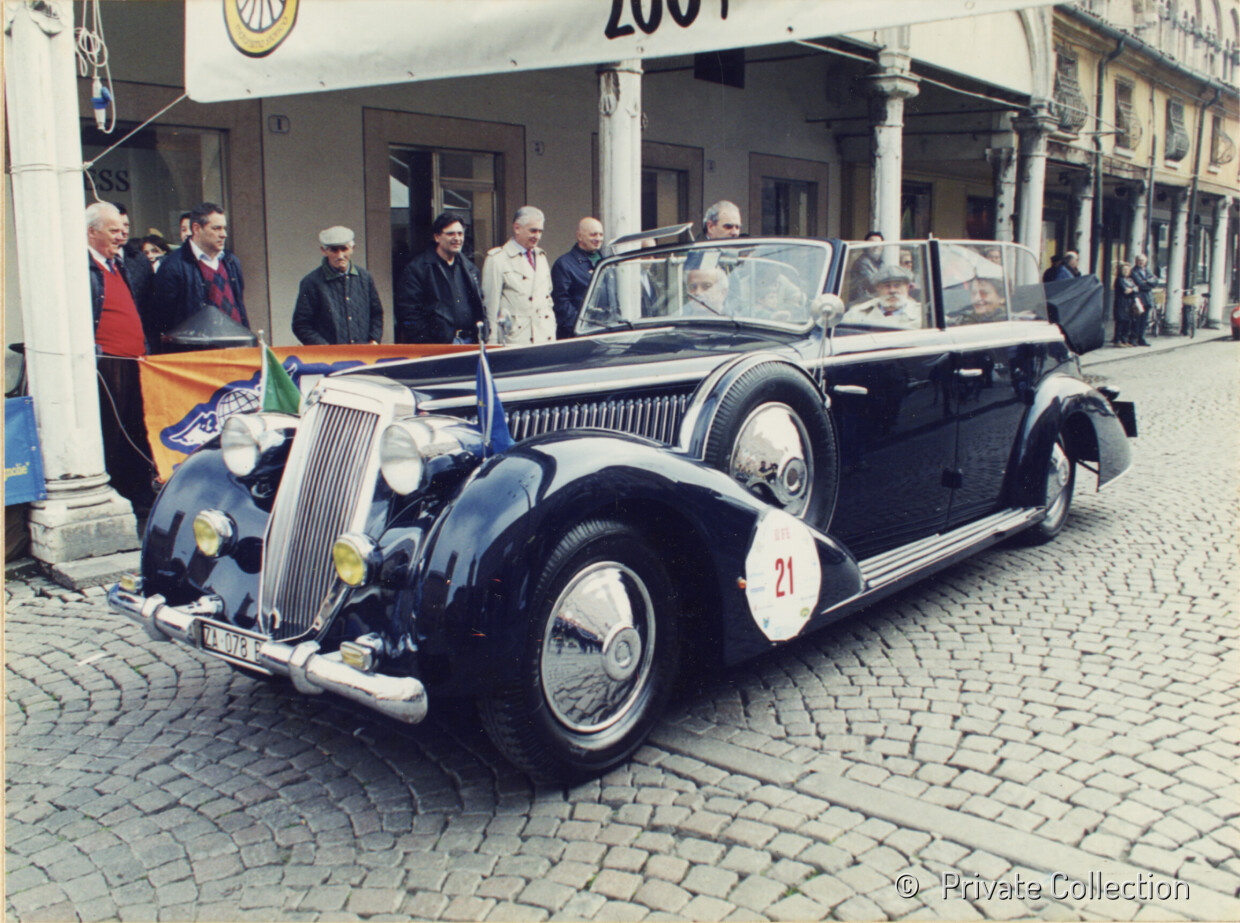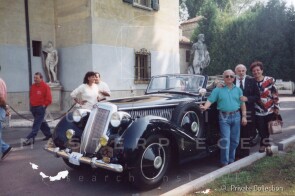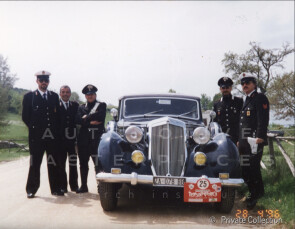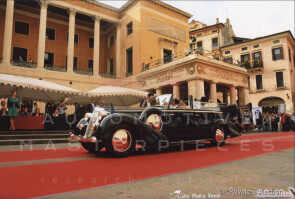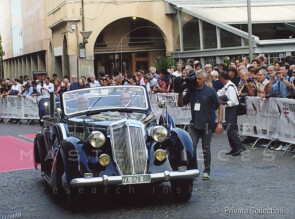
1939 Lancia Astura 4a serie
ON/OFF
Why am I an Automotive Masterpiece?
K. Famous chassis’ cars
Last of 7 chassis bodied by Boneschi in this specific configuration for the Ministry of the Interior.
L. Limited edition cars
no. 7 manufactured, 7th built. 5 built in 1938, 2 built in 1939
The Lancia Astura was a car produced by the Turin-based company from 1931 to 1939. In the early 1930s, Lancia’s latest model was the large Dilambda (launched in 1929), while the Lambda—after nearly a decade in production—was due to be replaced. The Dilambda featured a V8 engine with a 4-liter displacement, whereas the Lambda, originally equipped with a 2.1-liter engine, reached over 2.5 liters in its final series. Although the Dilambda retained its flagship status, Lancia decided to replace the Lambda with two new models aimed at different customers: the Artena, a 4-cylinder car with a displacement under 2 liters, and the Astura, fitted with a 2.6-liter V8 engine. The two models were mainly differentiated by their engines but also had different wheelbases: the Artena had a 299 cm wheelbase, while the Astura’s was 19 cm longer to accommodate the larger engine. Unlike previous Lancia models, the Astura was named after a historic castle near the Roman city of Nettuno. Its V8 engine, with a 19° angle between banks, was a simplified and downsized version of the Dilambda unit, with a displacement of 2606 cc and an output of 72 hp at 4000 rpm. In addition to a cast-iron engine block, triple chain-driven distribution, and a self-cleaning oil filter, the engine’s most distinctive feature was its unique two-piece cylinder head: the lower part (cast iron) housed the valves, while the upper part (aluminum) contained the rocker arms and their shaft, with the central camshaft rotating between the two. The water-based cooling system, derived from the Artena, included a thermostat-controlled throttling device. The Astura also shared the centralized lubrication system with the Artena. Moving away from the unitary body construction of the Lambda, both the Astura and the Artena employed a chassis made of two vertical box-section side members reinforced by an X-shaped brace. Two longitudinal round tubes branched from a central cross-member and were integrated into the front ends of the side members, which slightly converged. The suspension system combined different solutions: at the front, Lancia’s classic layout was retained—though without the diagonal braces that, in the Lambda, had connected the radiator frame to the suspension cylinders, now made redundant by improved chassis rigidity—while the rear used a conventional live axle with semi-elliptical leaf springs and Siata friction shock absorbers. Powered by a Zenith double-barrel carburetor, the Astura offered excellent performance thanks to its favorable power-to-weight ratio. The chassis weighed just under a ton (960 kg), and even the sedan version remained relatively light at 1,250 kilograms, enabling a top speed of around 125 km/h. While Lancia did produce a sedan version—available with either four windows and 4–5 seats or six windows and 6–7 seats—the Astura became the queen of custom coachbuilt cars of its era. Nearly all major Italian coachbuilders, as well as several international ones, created special-bodied examples. Notable names included Bertone, Boneschi, Borsani, Brianza, Castagna, Colli, Garavini, Ghia, Stabilimenti Farina, Touring, and Viotti, along with international firms such as Weinberger & Buhne, John Charles, Abbott, and Kevill Davies & March. A cabriolet by Pinin Farina, built in 1936, was awarded Best of Show at the Pebble Beach Concours d’Elegance in 2016. Another cabriolet by Stabilimenti Farina won the 1947 edition of the Concorso d’Eleganza Villa d’Este, although it never entered mass production. First introduced at the Paris Motor Show in October 1931, the Astura underwent a minor update about a year later (Second Series). In 1933, with the Third Series, more significant changes were introduced: the chassis was made available in two different wheelbase lengths, the engine displacement was increased (from 2.6 to 3 liters), power was improved by about 10 hp, and the braking system was revised. Further significant changes were made to the chassis in 1937 with the Fourth Series, which effectively replaced the discontinued Dilambda. Chassis from this series were often used for official government vehicles, mostly designed by Boneschi and Pinin Farina, sometimes with monumental proportions. The engine of the final Astura series also served as the basis for the Lince armored car, occasionally referred to as the “Astura armored car.” A total of 2,912 Astura units were produced.
Launched in 1937, the fourth and final series of the Astura introduced further refinements, while repositioning the model toward a more institutional and formal role. The chassis retained the two available wheelbase lengths, but featured additional structural reinforcements to meet the needs of coachbuilders tasked with creating official vehicles. Most examples of this series were bodied as limousines, landaulets, or formal sedans by renowned ateliers such as Pinin Farina and Boneschi, often distinguished by imposing and monumental proportions. Mechanically, the engine remained the 3-liter V8 introduced with the third series, though minor adjustments were made to improve reliability and torque delivery. Thanks to its combination of power, refinement, and versatility for coachbuilding, the Astura Series IV became the favored base for state ceremonies, diplomatic duties, and military staff cars. A number of these vehicles, especially those with long-wheelbase chassis, were later preserved in museum collections or continued to be used into the early postwar years.
The 1939 Lancia Astura 4a Serie, chassis no. 41-3297, was completed in terms of chassis and mechanical components in the first half of 1939 and delivered to Boneschi for coachbuilding on August 4, 1939. In its internal register, the coachbuilder numbered the car 134 and described it as a “cabriolet, sei posti, sei luci” (six-passenger, six-window convertible). According to available records, only seven cars with this type of imposing bodywork were built by Boneschi, all commissioned by the Italian Ministry of the Interior. Five examples were constructed and delivered in January 1938 (chassis numbers 2935, 2930, 2932, 2934, and 2928), while only two chassis—3294 and 3297—were completed in this configuration in August 1939. This example is not only one of those final two, but also the last of the seven Lancia Astura 4a Serie to be bodied by Boneschi in this specific configuration. It is also the last vehicle bodied by Boneschi for the Ministry of the Interior. Only six more cars would be bodied by Boneschi after this one before wartime conditions brought production to a halt. The registered customer of chassis no. 41-3297 was nominally Lancia & C., but, as indicated in the client file, the order was placed on behalf of the Ministero degli Interni. During the Fascist regime, the Italian Ministry of the Interior was formally headed by Benito Mussolini, while the ministry’s daily operations and administrative responsibilities were effectively managed by Undersecretary Guido Buffarini Guidi. Under his authority, the ministry oversaw civil governance, provincial prefectures, and the allocation of official vehicles for institutional use. In this context, the Astura—Lancia’s most prestigious model at the time—was the natural choice for high-level representation. Vehicles of this kind were typically used to transport senior government officials, prefects, or visiting dignitaries. Some were assigned to major provincial capitals, others deployed for national ceremonies or parades. Even if commissioned by the Italian Ministry of the Interior, recently consulted registration records indicate as the registered owner the Ministry of Finance, General Procurement Office of the State, in Rome. It can easily be assumed that its use was to be part of the official government fleet, intended either for the Minister of Finance—at the time Pietro Aloisi Jung, and until mid-year Paolo Thaon di Revel—or for senior officials of the Ministry. It could also serve as a ceremonial car in public events or state occasions, and in those years of preparation for war and grand regime celebrations it might be placed at the disposal of foreign delegations or even members of the Royal Family.Additional context makes it plausible that the Astura could have been assigned to the Prefect of Turin, Carlo Tiengo, who held office between 1936 and 1941 as the highest representative of the Ministry of the Interior in the city. In early August 1939, Turin was at the center of the large-scale military maneuvers that brought together troops and senior figures of both the army and the Fascist regime. The most prominent government representative present was General Alberto Pariani, who officially met with Prefect Tiengo. On August 4, 1939—the very date when the Astura chassis was delivered to Boneschi—King Victor Emmanuel III received the city’s authorities at Palazzo Reale, including Prefect Tiengo. Just days later, on August 16, 1939, the concluding ceremony of the maneuvers took place in Turin in the presence of the King, Prefect Tiengo, and thousands of military vehicles. It is therefore conceivable, though not documented, that the Astura could have been deployed in Turin on such high-profile occasions, possibly as an official car for the Prefect or for dignitaries attending the events. The ministerial Astura with chassis no. 41-3297 presented an imposing yet elegant presence, symbolizing the authority and prestige of the state. There is no documentary evidence or historical testimony of its participation in specific events, nor has its confirmed presence at public parades transporting political leaders of the era been established—although such a use is highly probable. Acquired by Aldo Gadioli, an Italian classic car collector and enthusiast, the car was purchased mid 1990s from a dealer in Suzzara. It was restored by Alberto Varini (Concordia, Modena) for the bodywork and by Torelli for the mechanical components. It was re-registered in Italy and received ASI certification. Under Gadioli’s ownership, the car saw an extended and active season of participation in classic car events from the late 1990s through to 2024, when it was sold to another Italian collector.
